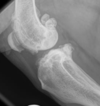Musculoskeletal 1 Flashcards
What is lameness?
Abnormal gait or stance - dysfunction of locomotor system
What are the three main causes of lameness?
- Pain
- Mechanical
- Neurological
What are the three main steps involved in localising origin of lameness?
- Confirm musculoskeletal condition present - general physical examination
- Identify which limb(s) are site of lameness - standing and gait examination
- Part of musuloskeletal system causing lameness - pain versus mechanical
What is the name of the condition that is shown below and how does it cause lameness?

Panosteitis - acute onset - vascular proliferation and congestion in medulla, bone formation around nutrient foramen and periostium. Result in increased intraosseous pressure which is painful.
Name the condition that is shown below and explain how it can cause lameness:

Hypertrophic osteodystrophy - results in painful metaphyseal bone - seen as trabecular disruption and necrosis with haemorrhage + haemosiderin deposits, inflammatory cells and fibrosis - can result in ALD
Name the condition that is shown below:

Bone tumours:
- Moderate - severe lameness
- Loss of structural integrity - fracture
- Inflammation
What is the condition that is shown below?

Degenerative joint disease: degradation of articular cartiladge, synovitis, altered subchondral bone metabolism. This causes painful joints, reduced ROM, stiff gait and trouble rising, muscle wasting, periarticular fibrosis
What is the condition shown below and what symptoms may be seen?

Septic arthritis - swelling, pain, warmth, lymphadenomegaly, pyrexia
What is the name of the condition that is shown below and what are the clinical signs?

Immune mediated polyarthritis (IMPA) - multiple painful, swollen joints, generalised stiffness, pyrexia, secondary degenerative changes, periarticular fibrosis
Name the group of conditions that is shown below and provide the three main causes of them:

- Premature growth plate closure - Limb length discrepancy or ALD
- Developemental conditions - patella luxation
- Painful joint incongruity and degenerative joint disease
What is the name of the conditon that is shown below?

Cruciate ligament disease
What is the name of the condition that is shown below? (the animal is jerking its affected leg when raised)

Gracilis and semitendinosis contracture
What is the name of the condition shown below?

Quadriceps muscle contracture
What is the name of the condition shown below and how does it result in pain?

Compartement syndrome - swelling, oedema, pain, severe lameness, increased interstitual pressure in osteofacial compartement + reduced tissue perfusion - pain due to ischaemia and tissue damage
Name the condition that is shown below:



